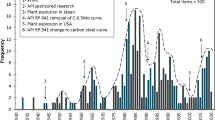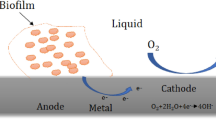Abstract
Corrosion of rebar in concrete structures is one among the various causes impairing its long-term durability. Precise assessment of corrosion rate (CR) is of prime importance to evaluate the structural safety as well as for estimation of service life of concrete structures. Among the electrochemical techniques, Galvanostatic Pulse Technique (GPT) is very promising for field mapping due to its rapidity. The reliability of GPT in determining the CR under passive and active state of rebar has been carried out using small size laboratory specimens and large scale aged concrete structures. The CR determined by the GPT is compared with the CR obtained by Electrochemical Impedance Spectroscopy Technique (EIST) and weight-loss method. The study reveals that an anodic pulse of 100 μA with a pulse duration of 10 seconds is able to determine the CR from 1–663 μm/y (from negligible to higher corrosion activity) on the rebar network more precisely even up to 65 mm of cover concrete. For instance the rebar corroding at higher rate, the CR predicted by GPT is very close to the CR by weight-loss method whereas it is 20 times less by EIST. In the case of passive state of rebar, the CR predicted by EIST is very close to weight-loss method whereas GPT predicts 10 times higher. In aged structures, the change in microstructure of concrete and loss of moisture from the concrete make the potential of rebar and resistivity of concrete more unpredictable and mislead the status of rebar embedded inside the concrete.
Similar content being viewed by others
References
ASTM C876-91 (2001). “Standard test method for half-cell potentials of uncoated reinforcing steel in concrete.” ASTM Standards Developed by Subcommittee, Vol. 03.02,G.1.14, pp. 42–49.
ASTM G1-90 (2003) “Standard practice for preparing, cleaning and evaluating corrosion test specimens.” ASTM Standards, Active Standard Developed by Subcommittee: G01.05, Vol. 03.0, pp. 9–18.
Basseler, A. and Burkert, A. (2003) Usage of GPM portable equipment for determination of corrosion stage of concrete structures, Corrosion, Paper No.03388, NACE International, Houston, Texas, USA.
Biegovic, D., Stipanovic, I., Staliz, M., Feric, K., and Barbalic, I. (2004). “Case study — corrosion monitoring in marine environment in Croatia.” University of Zagreb Special Paper.
Birbilis, N., Nairn, K. M., and Forsyth, M. (2003) “Transient response analysis of steel in concrete.” Corrosion Science, Vol. 45, No. 9, pp. 1895–1902.
Birbilis, N., Naivn, K. M., and Forsyth, M. (2004) “On the electrochemical response and interfacial properties of steel Ca(OH)2 and the steel concrete system measured using galvanostatic pulses.” Electrochemica Acta, Vol. 49, No. 25, pp. 4331–4339.
Broomfield, J. P. (1991) “Life prediction of corrodible structures.” Proc. NACE Symposium, Cambridge, Paper14.
Elsener (2005). “Corrosion rate of steel in concrete-measurements beyond the Tafel law.” Corrosion Science, Vol. 47, No. 12, pp. 3019–3033.
Feliu, S., González, J. A., Andrade M. C., and Feliu, V. (1989). “Determining polarization resistance in reinforced concrete slab.” Corr. Sci., Vol. 29, No. 1, pp. 105–113.
Flis, J., Pickering, H. W., and Osseo-Asare, K. (1995). “Assessment of data from tree electrochemical instruments for evaluation of reinforcement corrosion rates in concrete bridge components.” Corrosion., Vol. 51, No. 8, pp. 602–609.
Frolund, T., Jensen F. H., and Bassler, R. (2002) “Determination of reinforcement corrosion rate by means of the galvanostatic pulse technique.” First International Conference on Bridge Maintenances IABMAS 2002., Barcelona, Spain.
Glass, G. K., Page, C. L., Short N. R., and Zhang, J.-Z. (1997) “The analysis of potentiostatic transients applied to the corrosion of steel in concrete.” Corrosion Science., Vol. 39, No. 9, pp. 1657–1662.
Gonzalez, J. A., Cobo, A., Gonzalez, M. N., and Felin, S. (2001) “Onsite determination of corrosion rate in reinforced concrete structures by use of galvanostatic pulses,” Corrosion Science, Vol. 43, No. 4, pp. 611–625.
Gonzalez, J. A., Mirinda, J. M., and Feliu, S. (2004). “Considerations on the reproducibility of potential and corrosion rate measurements in reinforced concrete.” Corrosion Science, Vol. 46, No. 10, pp. 2467–2485.
Grantham, M. G., Associates, M. G., Barnet, Herb, and Broomfield, J. (1997). “The use of linear polarisation corrosion rate measurements in aiding rehabilitation options for the deck slabs of a reinforced concrete underground car park.” Constr. Build. Mater., Vol. 11, No. 4, pp. 215–224.
Gulikers, J. and Polder, R. (2003). “Critical evaluation of methods to assess the corrosion rate in reinforced concrete structures.” Proceeding on structural faults and repairs-2003, Tenth Intn. Conf, The common wealth Institute, London, UK.
Hachani, L., Fiaud, C., Triki, E., and Reharinaivo, A. (1994). “Characteristics of steel/concrete interface by Electrochemical impedance spectroscopy.” British Corrosion Journal, Vol. 91, No. 3, pp. 66–74.
Jones, D. A. (1996). “Polarization methods to measure corrosion rate.” In: Stenquist B, Kernan R, editors. Principles and Prevention of Corrosion, 2nd ed. Upper Saddle River: Prentice-Hall, Inc., pp. 143–168.
Mccarter, W. J. and Brousseau, R. (1990) “The A.C. response of hydrated cement paste.” Cement and Concrete Research., Vol. 20, No. 6, pp. 891–900.
Myrdal, R. (1996). “Phenomena that disturb the measurements in concrete.” Proc. Corrosion /96, Paper No.96339, 1996, (Houston, USA/NACE International)
Myrdal, R. (1997). “Potential gradients in concrete caused by charge separations in a complex electrolyte.” Proc.Corrosion /97, Paper No.97278, (Houston, USA/ NACE International).
Newton, C. J. and Sykes, J. M. (1988). “A.galvanostatic pulse technique for investigation of steel corrosion of steel in concrete.” Corrosion Science, Vol. 28, No. 11, pp. 1051–1074.
Sagoe-crentsil, K. K., Glasser, F. P., and Irvine, J. T. S. (1992). “Electrochemical characteristics of reinforced concrete corrosion as determined by impedance spectroscopy.” British Corrosion Journal, Vol. 27, No. 2, pp. 113–121.
Sathyanarayanan, S., Panjali Natarajan., Saravanan, K., Srinivasan, S., and Venkatachari, G. (2006). “Corrosion monitoring of steel in concrete by galvanostatic pulse technique.” Cement and Concrete Composites, Vol. 28, No. 28, pp. 630–637.
Stern, M. and Geary, A. L. (1975). “Electrochemical polarization; I. A theoretical analysis of the shape of polarization curves.” J. Electrochem. Soc., Vol. 104, No. 1, pp. 56–62.
Videm, K. (1997). “Experience with galvanoststic pulse technique and other methods to assess rebar corrosion.” Corrosion-97, Paper No. 279, NACE, Houston, USA.
Videm K. and Myrdal, R. (1996). “The electrochemical behaviour of steel in concrete and how to evaluate the corrosion rate.” Proc. Corrosion/96, Paper No. 96348, 1996 (Houston, USA/. NACE International)
Zivica, V. (2001). “Possibility of improvement of potentio-dynamic method for monitoring corrosion rate of steel reinforcement in concrete.” Bull. Mater. Sci., Vol. 24, No. 5, pp. 555–558.
Author information
Authors and Affiliations
Corresponding author
Rights and permissions
About this article
Cite this article
Vedalakshmi, R., Balamurugan, L., Saraswathy, V. et al. Reliability of Galvanostatic Pulse Technique in assessing the corrosion rate of rebar in concrete structures: Laboratory vs field studies. KSCE J Civ Eng 14, 867–877 (2010). https://doi.org/10.1007/s12205-010-1023-6
Received:
Revised:
Accepted:
Published:
Issue Date:
DOI: https://doi.org/10.1007/s12205-010-1023-6




